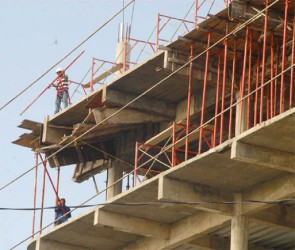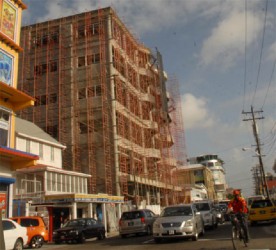Local Health and Safety Consultant Dale Beresford is advocating an officially backed “national fall prevention stand-down” in the construction industry, to allow “breathing space to raise awareness of preventing fall hazards in the sector.”
Beresford recently conducted an exhaustive interview on the theme of creating a more responsible safety and health culture in an expanding construction sector. Part of this was published in last Friday’s issue of the Stabroek Business. Beresford said he is calling for the exercise to enhance awareness among employers and employees about the importance of safety and health standards in a changing construction environment.
“We are now building them [structures] higher and higher these days and I am not sure whether all of the construction sites are putting in place the kinds of safety and health measures that go along with bigger, more complex types of structures. This is as good a time as any to start. It is a kind of reflection and correction initiative,” Beresford said.

The former Mayor and City Council employee said he envisages contractors setting aside periods on work sites to have “tool box talks” with workers. “I’m particularly concerned about falls from heights. Those continue to be a leading cause of death for construction workers, those deaths are preventable,” he said.

Beresford told Stabroek Business that he believes the Occupational Safety and Health Department of the Ministry of Labour should throw its weight behind the initiative and “use its clout” to try to have construction sites go along with the idea.
He said while he was aware that there were “cost and time considerations” associated with a stand-down, he believed it was “a small price to pay” for an exercise that is designed “to create an improved safety and health culture in the construction sector.” He added that while he believed that the Labour Ministry should support the exercise it was his view that the exercise should be voluntary.
According to Beresford, the safety stand-down should be used, particularly, “to reinforce the importance of fall-prevention.”
Asked about approaches to conducting the stand-downs Beresford said companies can do so “by taking a break to have a toolbox talk or another safety activity including conducting safety equipment inspections, developing rescue plans, or discussing job specific hazards.” He said building site managers should plan stand-downs that work best for their workplaces within a particular time frame. He said that the Ministry of Labour might wish to “kick off the initiative” by publicly announcing a time frame within which “employers are invited to conduct their stand-downs.”
And according to Beresford, stand-downs may be used to review fall prevention programmes including the types of falls that might occur and how these might be prevented. He said other contractors, technical experts, state agencies responsible for addressing safety and health and emergencies and the owners of buildings and members might be invited to witness and participate in the stand-downs.




